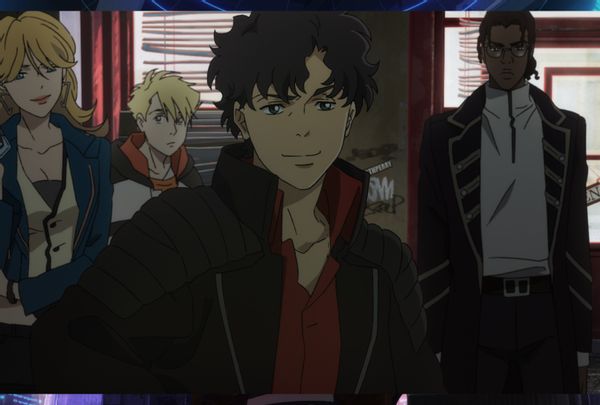“Cowboy Bebop” debuted on Adult Swim on an unsuspecting Sunday in September 2001, nine days before one Tuesday would shatter our sense of security forever: 9/11.
The rest of the shows on the mature animation block were comedies while “Cowboy Bebop” was anime, although unlike nearly anything else the genre’s American aficionados were accustomed to. Shinichirō Watanabe's vision marries futuristic visuals with realism, with the series' jazz score treated as something to be felt and then absorbed, like dry skin lathered in shea butter. Thus, the auteur shaped the Adult Swim brand’s lasting association with a vibe – that indescribable impression that made “Cowboy” character Spike Spiegel as much of a blue romantic as an ace bounty hunter.
Watanabe's latest, “Lazarus,” calls on familiar hints while transporting us to a future near enough to feel like the present, anxieties included. In his version of 2052, the cause of the world’s problems is its presumed cure: a drug called Hapna designed by a celebrated neuroscientist named Dr. Skinner and promoted as a panacea for suffering — as in, all somatic and psychic ills.
Hapna’s affordability and touted lack of side effects led to its global usage, followed by Skinner’s sudden disappearance. Three years after its launch, however, he resurfaces to announce that the drug was designed to be fatal three years after its ingestion, even if someone only took it once. And, surprise, only he has the antidote, giving the public 30 days to find him before the first Hapna users start dropping.
“Lazarus” is named for the underground team assembled to find Skinner, and “Cowboy Bebop” fans may not be able to ignore surface parallels between this and Watanabe’s late ‘90s jam session.
There’s a kid hacker, a former agent who shoots straight and loves starring in honey traps, and in the fore is Axel Gilberto, an acrobatic parkour nut and escape artist recruited straight out of the clink where he’s serving an 888-year sentence. (Which, he explains, isn’t due to a horrific crime but legal math; each failed escape doubles a person’s sentence.)
Watanabe's latest calls on familiar hints while transporting us to a future near enough to feel like the present, anxieties included.
Axel even resembles Spike, although he fights like John Wick, whose creator, Chad Stahelski, designs the action sequences. But those intersperse a plot that takes the team through wild cityscapes where we witness firsthand how people respond to knowing a countdown clock to their end is already in motion.
Some keep living as they were. Others, including a hedonistic club owner fond of abusing women, receive their just desserts, late though the hour may be. As with “Cowboy Bebop," the action in "Lazarus" matches a sonic quilt connecting Kamasi Washington’s jazz sensibilities with electronic landscapes by Bonobo and Floating Point. Familiarity with these names or their musical styles isn't essential. What matters is that the whole melds into an undeniable vibe.
Vibes, as a concept, have been maligned recently in the popular imagination. Pundits use the term disparagingly as a catch-all to describe a mode of thinking that’s entirely detached from hard data. The doom and gloom about an economy that was, until recently, described by The Economist as “the envy of the world” was dubbed a “vibe-cession.”
The frenzied excitement generated by Vice President Kamala Harris’ 11th-hour entry into the 2024 presidential race was questioned, if not dismissed, as a “campaign powered by vibes” by a “vibes candidate.”
We need your help to stay independent
Most of us consider vibes to be positive or neutral, a way of giving form to gut sensations or the buzz in your skin. Vibes, good ones, dominate Watanabe’s oeuvre via the curated playlists that bounce or glide behind his imagery. Whether the music adds extra flavor to his raging action scenes or amplifies an episode’s lazy backstroke through existential loneliness, you feel his work’s best moments in your bones.
That specialness makes “Cowboy Bebop” the prescription for sleepless nights, whether it’s because you can’t or don’t want to. The same is true of 2004's “Samurai Champloo” and its throbbing hip-hop heartbeat. The soundtrack to Watanabe’s 2014 fantasy “Space Dandy” is more upbeat compared to the music coloring “Lazarus.”
 "Lazarus" (Courtesy of Adult Swim )Out of all those cited shows, “Lazarus” most directly plugs into current anxieties, beginning with its voiceover narrations opening each episode. “I wonder why is it that life always requires us to overcome so much grief, suffering and all that other cr*p?” a woman’s voice asks.
"Lazarus" (Courtesy of Adult Swim )Out of all those cited shows, “Lazarus” most directly plugs into current anxieties, beginning with its voiceover narrations opening each episode. “I wonder why is it that life always requires us to overcome so much grief, suffering and all that other cr*p?” a woman’s voice asks.
She goes on to say she jumped at the chance to take Hapna because it cured the pain of heartbreak. “I thought, ‘That's weird. How can a broken heart ever be painless? Isn't this too good to be true? What if I'm just being duped?’ Those thoughts did cross my mind.”
This evenly delivered sobriety amid massive uncertainty is its own kind of narcotic.
The last five years have given us a fresh appreciation for calm, and Calm. But long before the pandemic moved us to take up meditation or practice our breathing techniques, there was Adult Swim’s late-night block, a loopy feast for the head merging absurdist comedy and art and mainstreaming anime.
While celebrity-voiced ASMR videos trended during the pandemic, Adult Swim quietly added Ambient Swim to Max, the streaming service owned by its parent company, Warner Bros. Discovery. Nearly every episode of Ambient Swim is a continuous loop of animated images growing and dissolving into each other, separated by style and theme. (One episode features pixelated “Rick & Morty” scenescapes; another is a long, mostly live-action sequence montage of aquarium outdoor shots goofily narrated by the star of “Joe Pera Talks with You.”)
These are meant to be the anesthetizing accompaniment to playlists featuring purveyors of sonic wallpaper made to help your whole body chill out — a vibe-fest, on demand.
Want a daily wrap-up of all the news and commentary Salon has to offer? Subscribe to our morning newsletter, Crash Course.
“Lazarus” arrives in the wake of “Common Side Effects,” another series casting the pharmaceutical industry as its own plague on the human condition. At the heart of both stories are questions asking whether pain is a necessary part of being human and, more pointedly, whether our carelessly destructive species deserves to exist. “Some folks are happy to hear the world is ending,” a woman in “Lazarus” admits.
She says this in a tone lacking emotional spikiness, accepting that truth as it is. This evenly delivered sobriety amid massive uncertainty is its own kind of narcotic, much in the same way that the trippy sequences in “Common Side Effects” wouldn’t be out of place on a hash bar’s video screen.
Like the space cowboys and ronin searching for purpose in his past series, the personalities populating “Lazarus” are anguished people navigating a broken world, refusing to resign themselves to the long dark but not beyond relaxing into the reality in front of it. Sometimes vibes are all we’ve got, and it's OK to be good with that feeling.
"Lazarus" premieres at midnight on Saturday, April 5, on Adult Swim.



Shares